现在完成时教学设计汇总
- 格式:docx
- 大小:19.42 KB
- 文档页数:11
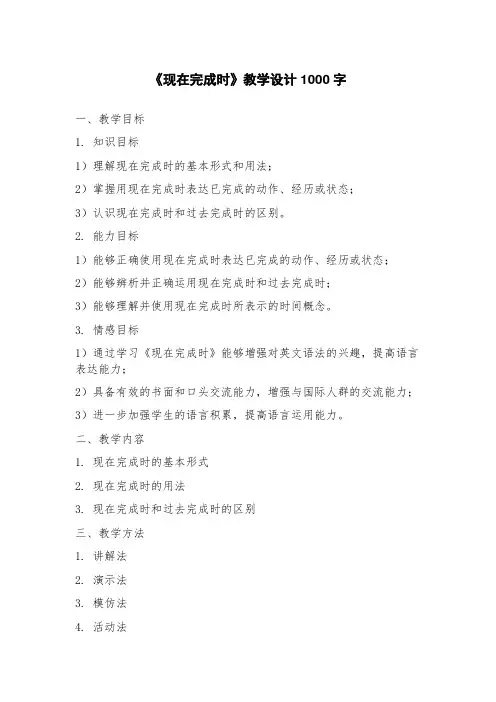
《现在完成时》教学设计1000字一、教学目标1. 知识目标1)理解现在完成时的基本形式和用法;2)掌握用现在完成时表达已完成的动作、经历或状态;3)认识现在完成时和过去完成时的区别。
2. 能力目标1)能够正确使用现在完成时表达已完成的动作、经历或状态;2)能够辨析并正确运用现在完成时和过去完成时;3)能够理解并使用现在完成时所表示的时间概念。
3. 情感目标1)通过学习《现在完成时》能够增强对英文语法的兴趣,提高语言表达能力;2)具备有效的书面和口头交流能力,增强与国际人群的交流能力;3)进一步加强学生的语言积累,提高语言运用能力。
二、教学内容1. 现在完成时的基本形式2. 现在完成时的用法3. 现在完成时和过去完成时的区别三、教学方法1. 讲解法2. 演示法3. 模仿法4. 活动法四、教学步骤1. 导入新课T:Class, do you know what the present perfect tense is? Now, please listen to a song and see if you can identify where the present perfect tense is used in the lyrics.(Old Time Rock and Roll, by Bob Seger)CT:I like that song! But what did you notice about the verb forms in the lyrics? Did you hear anything new?S1: Yes, I heard the word “have” and “has” followed by a past participle.S2: I heard “I’ve” and “you’ve” and “we’ve” before the verbs.CT: Good job! What you heard is the present perfect tense.2. 讲授现在完成时的基本形式T:Class, now let’s take a look at the form of the present perfect tense. (展示表格)I have eaten breakfast.He has seen that movie.We have played soccer.T:Notice that each sentence has two parts. The first part is the subject plus the present tense of “have” (either “has” or “have”), and the second part is the past participle of the verb. Together, they form the present perfect tense.3. 示范现在完成时的用法T:Class, now let’s look at how the present perfect tense is used. (展示表格)T:Do you understand? The present perfect tense is used to talk about something that happened at some time in the past, but we don’t know exactly when it happened.4. 练习现在完成时的用法T:Let’s practice using the present perfect tense together.I will make some sentences on the board and you can tell me if the verb form is correct or not.I have seen that movie last week.She has gone to China in 2019.We have studied English for five years.T: Which of these sentences are correct? Why?S1: “I have seen that movie last week” is incorrect because we use the past simple tense to talk about something that happened at a specific time in the past, not the present perfect tense.S2: “She has gone to China in 2019” is incorrect because we use the present perfect tense to talk about somethingthat happened at an unspecified time in the past, not the past simple tense.S3: “We have studied English for five years” is correct because we use the present perfect tense to talk about something that began in the past and continues up to the present.5. 引入现在完成时和过去完成时的区别T: Now, let’s talk about the difference between thepresent perfect tense and the past perfect tense. (展示表格)T: What do you notice about the difference between the two tenses?S1: The present perfect tense talks about things that happened recently or are still happening, while the pastperfect tense talks about things that happened before another event in the past.S2: The past perfect tense uses “had” + past participle, while the present perfect tense uses “have/has” + past participle.6. 归纳总结T: Well done. Now, let’s summarize what we have learned today. What is the present perfect tense and how is it formed?S1: The present perfect tense is used to talk about things that happened at some point in the past.S2: It is formed by using “have” or “has” with the past participle of the verb.T: And what is the difference between the present perfect tense and the past perfect tense?S3: The present perfect tense talks about things that happened recently or are still happening, while the past perfect tense talks about things that happened before another event in the past.七、作业1、根据要求改写下列句子:1. Tom has been to Paris. (对划线部分提问)2. I have lived here for ten years. (改为否定句)3. He has finished his work already. (改为一般疑问句)2、写一篇小短文,使用现在完成时描述过去一个星期内发生的事情八、板书设计Present Perfect TenseForm: Subject + have/has + past participleUse: To talk about something that happened at some point in the past, but we don’t know exactly when.例句:I have eaten breakfast. He has seen that movie. We have played soccer.区别:Present Perfect Tense: Talks about things that happened recently or are still happening.Past Perfect Tense: Talks about things that happened before another event in the past.。
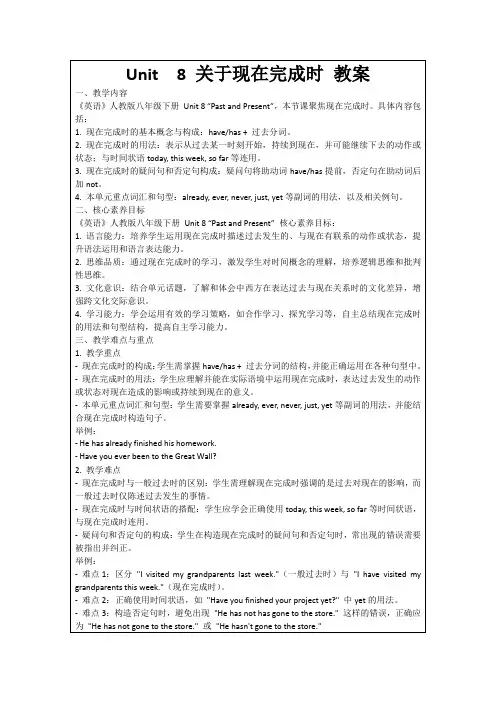
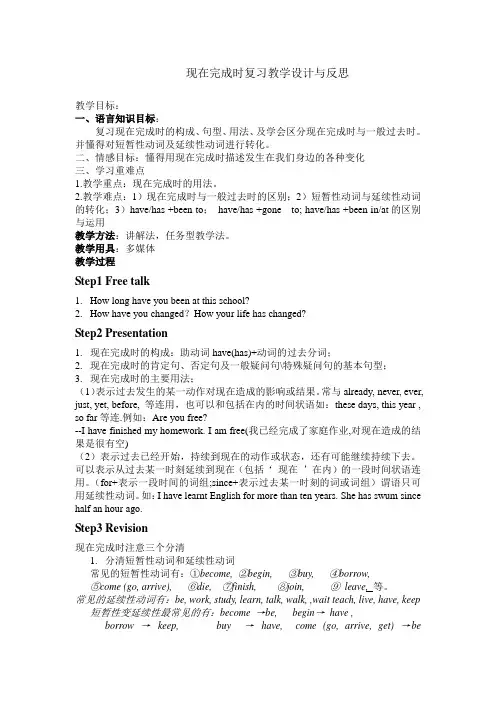
现在完成时复习教学设计与反思教学目标:一、语言知识目标:复习现在完成时的构成、句型、用法、及学会区分现在完成时与一般过去时。
并懂得对短暂性动词及延续性动词进行转化。
二、情感目标:懂得用现在完成时描述发生在我们身边的各种变化三、学习重难点1.教学重点:现在完成时的用法。
2.教学难点:1)现在完成时与一般过去时的区别;2)短暂性动词与延续性动词的转化;3)have/has +been to;have/has +gone to; have/has +been in/at的区别与运用教学方法:讲解法,任务型教学法。
教学用具:多媒体教学过程Step1 Free talk1.How long have you been at this school?2.How have you changed?How your life has changed?Step2 Presentation1.现在完成时的构成:助动词have(has)+动词的过去分词;2.现在完成时的肯定句、否定句及一般疑问句\特殊疑问句的基本句型;3.现在完成时的主要用法;(1)表示过去发生的某一动作对现在造成的影响或结果。
常与already, never, ever, just, yet, before, 等连用,也可以和包括在内的时间状语如:these days, this year , so far等连.例如:Are you free?--I have finished my homework. I am free(我已经完成了家庭作业,对现在造成的结果是很有空)(2)表示过去已经开始,持续到现在的动作或状态,还有可能继续持续下去。
可以表示从过去某一时刻延续到现在(包括‘现在’在内)的一段时间状语连用。
(for+表示一段时间的词组;since+表示过去某一时刻的词或词组)谓语只可用延续性动词。
如:I have learnt English for more than ten years.She has swum since half an hour ago.Step3 Revision现在完成时注意三个分清1.分清短暂性动词和延续性动词常见的短暂性动词有:①become, ②begin, ③buy, ④borrow,⑤come (go, arrive), ⑥die, ⑦finish, ⑧join, ⑨leave, 等。
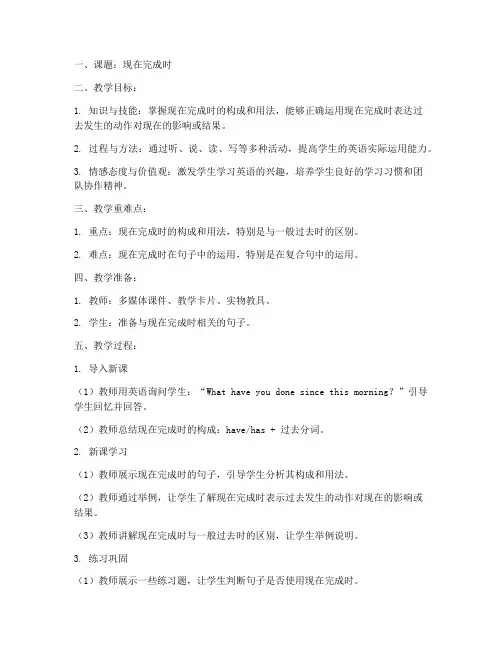
一、课题:现在完成时二、教学目标:1. 知识与技能:掌握现在完成时的构成和用法,能够正确运用现在完成时表达过去发生的动作对现在的影响或结果。
2. 过程与方法:通过听、说、读、写等多种活动,提高学生的英语实际运用能力。
3. 情感态度与价值观:激发学生学习英语的兴趣,培养学生良好的学习习惯和团队协作精神。
三、教学重难点:1. 重点:现在完成时的构成和用法,特别是与一般过去时的区别。
2. 难点:现在完成时在句子中的运用,特别是在复合句中的运用。
四、教学准备:1. 教师:多媒体课件、教学卡片、实物教具。
2. 学生:准备与现在完成时相关的句子。
五、教学过程:1. 导入新课(1)教师用英语询问学生:“What have you done since this morning?”引导学生回忆并回答。
(2)教师总结现在完成时的构成:have/has + 过去分词。
2. 新课学习(1)教师展示现在完成时的句子,引导学生分析其构成和用法。
(2)教师通过举例,让学生了解现在完成时表示过去发生的动作对现在的影响或结果。
(3)教师讲解现在完成时与一般过去时的区别,让学生举例说明。
3. 练习巩固(1)教师展示一些练习题,让学生判断句子是否使用现在完成时。
(2)教师引导学生用现在完成时造句,并分享自己的句子。
4. 小组活动(1)将学生分成小组,每个小组准备一个与现在完成时相关的场景。
(2)每个小组用英语描述自己的场景,并运用现在完成时进行表达。
5. 课堂小结(1)教师总结现在完成时的构成和用法,强调与一般过去时的区别。
(2)教师鼓励学生在日常生活中运用现在完成时,提高英语实际运用能力。
六、作业布置:1. 完成课后练习题,巩固所学知识。
2. 用现在完成时描述自己过去一周的经历,不少于50个单词。
七、板书设计:现在完成时构成:have/has + 过去分词用法:表示过去发生的动作对现在的影响或结果区别:一般过去时表示过去发生的动作,现在完成时表示过去发生的动作对现在的影响或结果。
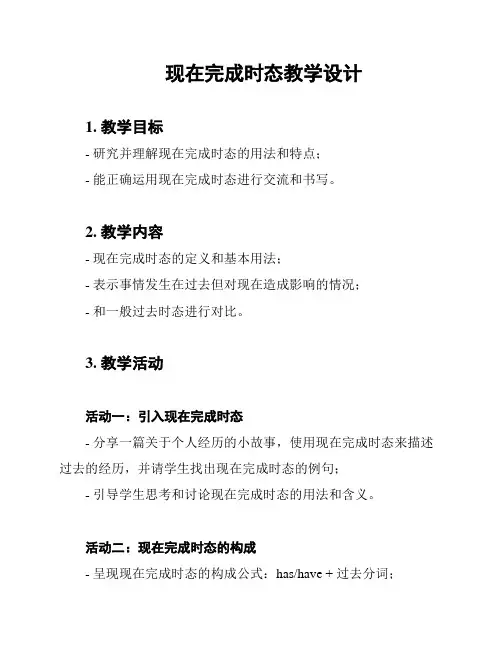
现在完成时态教学设计1. 教学目标- 研究并理解现在完成时态的用法和特点;- 能正确运用现在完成时态进行交流和书写。
2. 教学内容- 现在完成时态的定义和基本用法;- 表示事情发生在过去但对现在造成影响的情况;- 和一般过去时态进行对比。
3. 教学活动活动一:引入现在完成时态- 分享一篇关于个人经历的小故事,使用现在完成时态来描述过去的经历,并请学生找出现在完成时态的例句;- 引导学生思考和讨论现在完成时态的用法和含义。
活动二:现在完成时态的构成- 呈现现在完成时态的构成公式:has/have + 过去分词;- 通过示例句子和练,帮助学生掌握构成现在完成时态的基本规则。
活动三:现在完成时态的特点- 呈现现在完成时态和一般过去时态的对比:时间和状语的使用;- 通过练,让学生能够准确选择合适的时态来表达不同的含义。
活动四:运用现在完成时态进行交流- 分组活动:每个小组根据提供的话题,使用现在完成时态编写一个对话;- 每个小组表演对话,并相互评价。
活动五:书写练- 提供一些现在完成时态的写作练题,包括填空、改错和作文等,以测试学生对所学知识的掌握和应用。
4. 教学评估- 活动三中的对比练:考察学生对现在完成时态和一般过去时态的区别识别能力;- 活动四中的对话表演和评价:考察学生对现在完成时态的运用能力;- 活动五中的书写练:考察学生对现在完成时态的书写准确性和流利度。
5. 教学资源- 故事或文章素材;- 活动及练相关资料;- 评价表格。
6. 教学延伸- 学生可通过观看英语电影、阅读英文文章等方式进一步巩固现在完成时态的研究。
7. 总结本教学设计旨在帮助学生理解并掌握现在完成时态的用法和特点,通过不同的活动和练习,培养学生运用现在完成时态进行交流和书写的能力。
同时,鼓励学生通过延伸学习,提高英语综合运用能力。
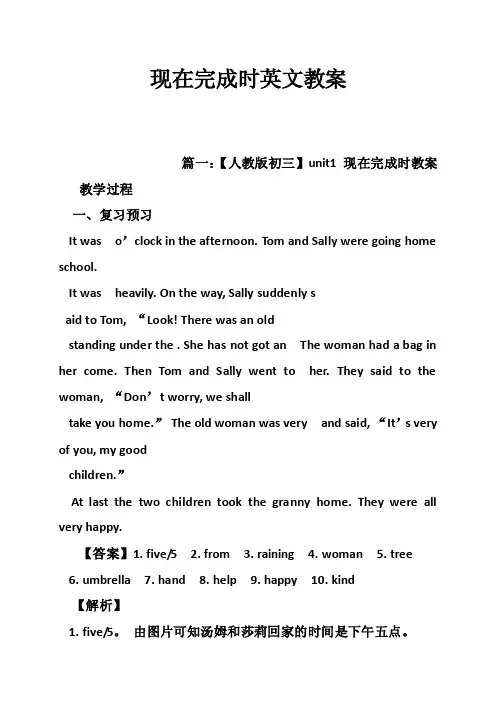
现在完成时英文教案篇一:【人教版初三】unit1 现在完成时教案教学过程一、复习预习It was o’clock in the afternoon. Tom and Sally were going home school.It was heavily. On the way, Sally suddenly said to Tom, “Look! There was an oldstanding under the . She has not got an The woman had a bag in her come. Then Tom and Sally went to her. They said to the woman, “Don’t worry, we shalltake you home.”The old woman was very and said, “It’s very of you, my goodchildren.”At last the two children took the granny home. They were all very happy.【答案】1. five/5 2. from 3. raining 4. woman 5. tree6. umbrella7. hand8. help9. happy 10. kind【解析】1. five/5。
由图片可知汤姆和莎莉回家的时间是下午五点。
2. from。
go home from school“放学回家”3. raining。
由图片可知雨正下得非常大。
4. woman。
由图片可知有一位老太太正站在树的下面。
5. tree。
由图片可知老太太是在树的下面,故填tree.6. umbrella。
由图片可知老太在树下避雨是因为没有带伞。
7. hand。
由图片可知老太太手里面有一包。
8. help。
由图片可知汤姆和莎莉跑过去帮助老太太。
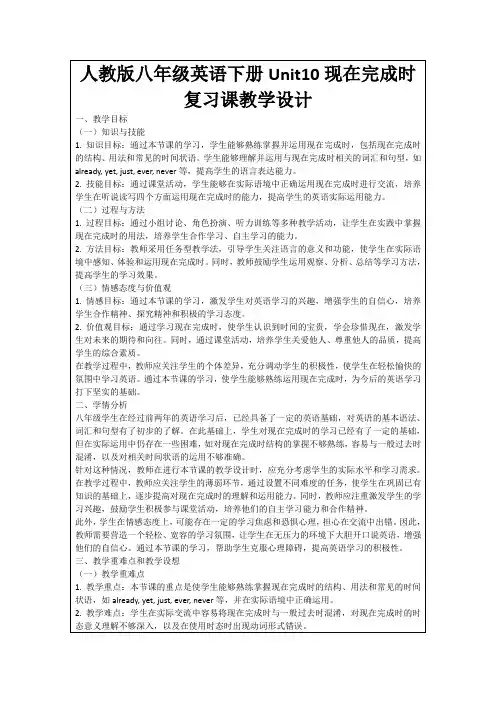
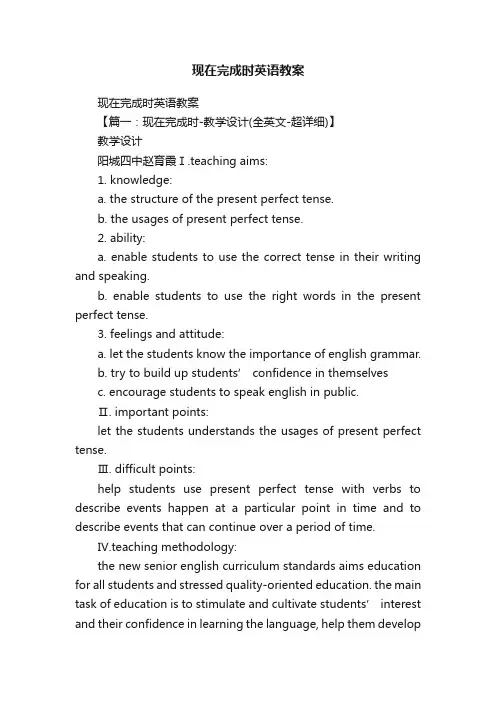
现在完成时英语教案现在完成时英语教案【篇一:现在完成时-教学设计(全英文-超详细)】教学设计阳城四中赵育霞Ⅰ.teaching aims:1. knowledge:a. the structure of the present perfect tense.b. the usages of present perfect tense.2. ability:a. enable students to use the correct tense in their writing and speaking.b. enable students to use the right words in the present perfect tense.3. feelings and attitude:a. let the students know the importance of english grammar.b. try to buil d up students’ confidence in themselvesc. encourage students to speak english in public.Ⅱ. important points:let the students understands the usages of present perfect tense.Ⅲ. difficult points:help students use present perfect tense with verbs to describe events happen at a particular point in time and to describe events that can continue over a period of time.Ⅳ.teaching methodology:the new senior english curriculum standards aims education for all students and stressed quality-oriented education. the main task of education is to stimulate and cultivate students’ interest and their confidence in learning the language, help them developgood learning habits and form effective learning strategies, facilitate autonomy and cooperative spirit in learning ; enable students to master basic english language knowledge and skills in listening, speaking, reading and writing.according to the new standards, the students should be the center of the class and the teacher serves as a controller, organizer, participant, or resource-provider most times. considered with the characteristic of the teaching contents and the learners, i will apply explanation and practicing in my teaching. most of the usages will be summarized by students themselves.Ⅴ.teaching tool: pptⅥ. teaching steps:step1. revision lead-in (2min)1.invite students to read sentences using present perfecttense they have found before the class.s1: i’ve seen quite a lot of china.s2: i’ve visited some beautiful cities.s3: they have just completed it.s4: ...2. show some sentences on the board.1). they have put up a lot of high-rise buildings recently.2). my wife’s just bought a beautiful dress from one of the shops there.3). it’s got some really pretty parks.4). a friend’s told me about a nice f ish restaurant.step2. present perfect tense1. the structure of present perfect tense.after reading these sentences, ask students to find the structure of these sentences with present perfect tense.1). have/has+done2). have/has+not+done3). have/has+been+done2. the usage of present perfect tenseplay the flash (a pig and his mom), and tell students to recall the main usages of this tense.q: the story happens in the past, but the pig and his mom use present perfect tense to describe it, can you tell me the reason? draw a time line on the blackboard:1). usage1: “完成用法”①强调过去发生的动作对现在造成的影响或结果,常用状语有:already, yet, never, ever, just, before ...e.g.1. i have just cleaned my hands.e.g.2. i have lost my wallet.e.g.3. i have already finished my homework. i am free.②show the following sentences and have students summarize the difference between the past simple tense and present perfect tense.he has already read that book. (说明他现在知道那本书的内容) he read that book last year. (只说明他去年读过那本书 )he has gone to america. (他现在不在此地, 在美国)he went to america eight weeks ago. (只说明他去过美国)summary:一般过去时表示过去发生的动作或存在的状态,与现在情况无关,常用时间状语为yesterday, last year, in the past等,而现在完成时与现在有关。
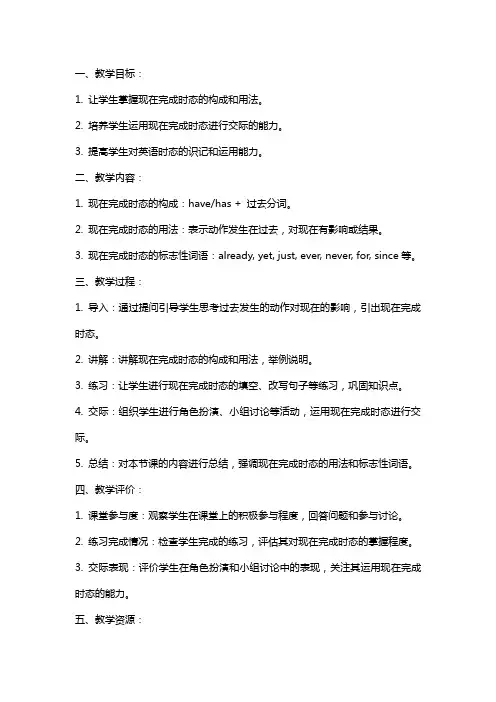
一、教学目标:1. 让学生掌握现在完成时态的构成和用法。
2. 培养学生运用现在完成时态进行交际的能力。
3. 提高学生对英语时态的识记和运用能力。
二、教学内容:1. 现在完成时态的构成:have/has + 过去分词。
2. 现在完成时态的用法:表示动作发生在过去,对现在有影响或结果。
3. 现在完成时态的标志性词语:already, yet, just, ever, never, for, since等。
三、教学过程:1. 导入:通过提问引导学生思考过去发生的动作对现在的影响,引出现在完成时态。
2. 讲解:讲解现在完成时态的构成和用法,举例说明。
3. 练习:让学生进行现在完成时态的填空、改写句子等练习,巩固知识点。
4. 交际:组织学生进行角色扮演、小组讨论等活动,运用现在完成时态进行交际。
5. 总结:对本节课的内容进行总结,强调现在完成时态的用法和标志性词语。
四、教学评价:1. 课堂参与度:观察学生在课堂上的积极参与程度,回答问题和参与讨论。
2. 练习完成情况:检查学生完成的练习,评估其对现在完成时态的掌握程度。
3. 交际表现:评价学生在角色扮演和小组讨论中的表现,关注其运用现在完成时态的能力。
五、教学资源:1. PPT课件:展示现在完成时态的构成、用法和标志性词语。
2. 练习题:提供现在完成时态的填空、改写句子等练习。
3. 角色扮演道具:用于学生进行角色扮演活动。
4. 小组讨论话题:提供相关话题,引导学生进行小组讨论。
六、教学步骤:1. 复习导入:通过提问学生关于他们已经学过的现在完成时态的知识,复习之前的学习内容。
2. 实例分析:通过展示一些具体的例子,让学生进一步理解现在完成时态的用法和构成。
3. 练习巩固:设计一些练习题,让学生进行现在完成时态的填空、改写句子等,以巩固他们的知识。
4. 小组活动:将学生分成小组,让他们通过讨论和交流,共同完成一些有关现在完成时态的任务。
5. 课堂总结:对这节课的内容进行总结,强调现在完成时态的重要性和使用场景。
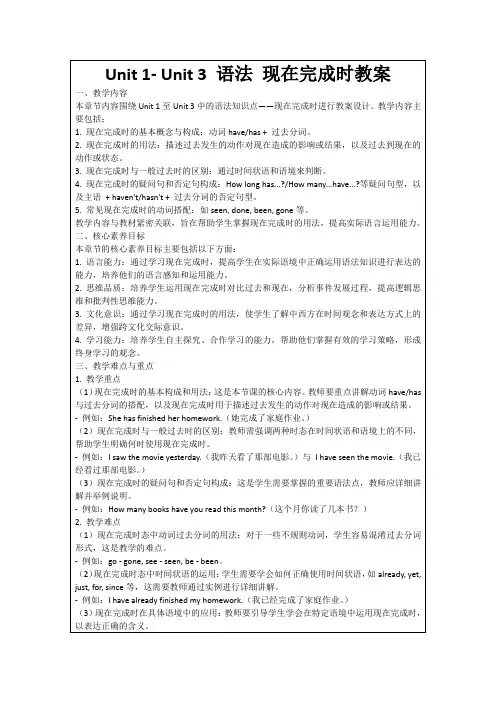
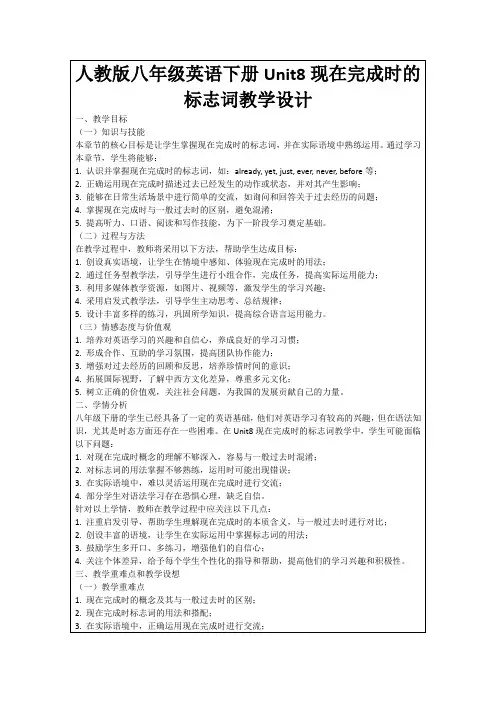
现在完成时课程设计一、课程目标知识目标:1. 学生能理解现在完成时的基本概念,掌握其构成及用法。
2. 学生能够运用现在完成时描述过去发生且对现在有影响的动作或状态。
3. 学生掌握现在完成时与一般过去时的区别,并能正确运用。
技能目标:1. 学生能够通过听力练习,理解并运用现在完成时进行日常交流。
2. 学生能够在口语和书面表达中,正确运用现在完成时描述相关情境。
3. 学生能够通过小组合作,运用现在完成时进行问题讨论和解决。
情感态度价值观目标:1. 学生在学习过程中,培养对英语学习的兴趣,增强自信心。
2. 学生通过课堂互动,培养合作精神,提高团队协作能力。
3. 学生能够认识到语言学习的实用价值,激发学习动力。
课程性质:本课程为英语语法教学,以现在完成时为主要教学内容,旨在帮助学生掌握英语时态,提高英语表达能力。
学生特点:六年级学生已具备一定的英语基础,对现在完成时有一定了解,但需进一步巩固和拓展。
教学要求:注重实践,关注学生个体差异,通过多样化的教学活动,提高学生的听说读写能力。
将目标分解为具体学习成果,便于教学设计和评估。
二、教学内容1. 引入现在完成时的概念,通过对比一般过去时,让学生感知两者的区别。
- 教材章节:第五章第三节2. 讲解现在完成时的构成,包括助动词have/has,过去分词形式。
- 教材章节:第五章第四节3. 演示现在完成时的用法,结合实际语境,让学生学会描述过去发生且对现在有影响的动作或状态。
- 教材章节:第五章第五节4. 设计听力练习,让学生在语境中感知现在完成时的应用,提高听力理解能力。
- 教材章节:第五章第六节5. 口语练习:通过角色扮演、小组讨论等形式,让学生在实际交流中运用现在完成时。
- 教材章节:第五章第七节6. 书面表达练习:指导学生运用现在完成时书写句子和短文,提高写作能力。
- 教材章节:第五章第八节7. 小组合作活动:设计相关任务,让学生在实际操作中巩固现在完成时的用法。
现在完成时( 一 )现在完成时表示过去发生的动作对现在造成的影响或结果,也可以表示从过去某一时间开始,一直持续到现在的动作或状态。
常与already“已经”,just“刚刚”,ever“曾经”,never“从不”,before“以前”,yet“仍然”等连用。
1.现在完成时的结构:2.already与yet在现在完成时中的用法:already adv.已经;早已通常用于肯定句中,一般用于have/has后,实义动词前,也可放在句尾。
例如:I have already had breakfast.我已经吃过早饭了。
yet adv.还;已经用于否定句和疑问句中,一般用在句末。
例如: I haven’t done my homework yet.我还没有做作业。
3.一般过去时与现在完成时的区别:( 1 )一般过去时表示过去某时发生的动作或单纯叙述过去的事情;现在完成时强调过去的动作对现在造成的影响或结果。
例如:I saw this film yesterday.我昨天看了这部电影。
I have seen this film.这部电影我已经看过了。
( 2 ) 一般过去时常与具体的表示过去的时间状语( 如yesterday,last week,three days ago,in 1990等 )连用;现在完成时不与表示明确的过去的时间状语连用,但可以与in the past...years/weeks,so far等时间状语连用。
例如: Tom wrote a letter to his parents last night.昨晚汤姆给他父母写了一封信。
The weather has been so hot so far this summer.到目前为止,今年夏天天气一直很热。
Ⅰ.根据句意用所给词的适当形式填空1.I have already had ( have )lunch.I had( have ) it at 11:30.2.—Have you written ( write ) to your parents yet?—Yes,I wrote ( write ) to them last night. 3.—How clean the classroom is!—Yes,I’m sure that someone has cleaned ( clean ) it.4.Jerry started ( start ) to write the letter yesterday,but he hasn’t finished( not finish ) it yet.5.Mr.Brown has taught ( teach ) Amy French for a mon th,but she still can’t speak French well.Ⅱ.单项填空( B )1.—I heard you lost your book. youit?—Not yet.A.Did;findB.Have;foundC.Do;findD.Have;find( A )2.She has decided what to buy for her best friend.A.alreadyB.yetC.stillD.neither( B )3.—How do you like Treasure Island,Lucy?—It’s so exciting that I it twice already.A.am readingB.have readC.was readingD.had read( C )4.—Where are the flowers?—You see,someone them to the windows.A.movesB.will moveC.has movedD.would move( D )5.—The storybook is very interesting.—I agree with you.I it many times already.A.readB.will readC.am readingD.have read( C )6.—Has she finished her homework yet?—.She finished it ten minutes ago.A.No,she hasB.Yes,she doesC.Yes,she hasD.No,she hasn’t( A )7.I the book Little Women yet,but I’ll let you read it first.A.haven’t readB.don’t readC.won’t readD.didn’t read( B )8.Paula was pleased that she her lost watch yesterday.A.findsB.foundC.has foundD.will find( D )9.I can’t find my wallet anywhere.I’m sure Iit.A.lostB.will loseC.loseD.have lost( D )10.William Shakespeare for over 400 years,but his works still have great influence today. A.died B.was dyingC.has diedD.has been dead。
现在完成时教案(共9页) -本页仅作为预览文档封面,使用时请删除本页-现在完成时教案一.背景介绍(一)教材分析:本课为初三年级语法复习课,在已经复习完动词一般现在时,一般过去时,一般将来时,现在进行时和过去进行时的基础上,进行动词时态中最重要的现在完成时的复习。
课时分配为两个小时的讲练结合课。
(二)学情分析:学生在初二年级学习过现在完成时后,一直没有进行过系统的复习。
在前阶段的语法复习中能够看出来学生的对于该语法项目遗忘程度比较严重。
而现在完成时在中考中的地位较高,是单选的每年必考的项目,所以针对学生的现状和考试的要求,都要在该时态复习时下一番功夫。
二.教学设计(一)教学目标1、复习现在完成时的构成和两种基本用法。
2、现在完成时与一般过去时的区别。
3、have been to, have gone to和have been in的用法。
(二)教学重点:现在完成时的两种基本用法。
(三)教学难点:1.现在完成时与一般过去时的区别。
been to, have gone to和have been in的用法。
三.课堂流程:Step 1 warm upTranslate the following sentences1. I have lived in Beijing.2. He has already seen the film.3. I have not had his lunch yet.4. She has not visited your school before.5. Have you ever been to the Forbidden City before6. I have never been to that farm before.7. I have just lost my English book.Step 2 presentation1. 现在完成时构成主语+have / has + 过去分词+~2. 意义1)现在完成时态表示过去发生的动作对现在造成的影响或结果。
一、课题名称《现在完成时》二、教学目标1. 知识与技能目标:(1)学生能够正确理解现在完成时的概念和用法。
(2)学生能够熟练运用现在完成时进行日常交流。
2. 过程与方法目标:(1)通过小组讨论、案例分析等活动,提高学生的自主学习能力。
(2)通过角色扮演、情景模拟等活动,提高学生的口语表达能力。
3. 情感态度与价值观目标:(1)培养学生对英语学习的兴趣和积极性。
(2)增强学生的跨文化交流意识,提高学生的国际视野。
三、教学重难点1. 教学重点:(1)现在完成时的构成:have/has + 过去分词。
(2)现在完成时的用法:表示过去发生的动作对现在的影响或结果。
2. 教学难点:(1)现在完成时的否定和疑问句形式。
(2)现在完成时与一般过去时的区别。
四、教学准备1. 教师准备:(1)多媒体课件,包括现在完成时的定义、用法、例句等。
(2)相关练习题和答案。
(3)情景模拟、角色扮演等教学活动素材。
2. 学生准备:(1)预习课文,了解现在完成时的基本用法。
(2)准备与现在完成时相关的日常用语。
五、教学过程1. 导入(1)教师简要介绍现在完成时的概念和用法。
(2)播放一段关于现在完成时的视频,激发学生的学习兴趣。
2. 新课学习(1)教师讲解现在完成时的构成和用法,结合例句进行说明。
(2)学生跟读、模仿,巩固所学知识。
3. 小组讨论(1)将学生分成小组,讨论现在完成时的用法。
(2)每组派代表分享讨论成果,教师点评并总结。
4. 练习巩固(1)教师布置练习题,学生独立完成。
(2)教师批改作业,纠正错误。
5. 情景模拟(1)学生分组进行角色扮演,运用现在完成时进行对话。
(2)教师巡回指导,帮助学生提高口语表达能力。
6. 总结与作业(1)教师总结本节课所学内容,强调重点和难点。
(2)布置课后作业,巩固所学知识。
六、教学反思1. 教学过程中,关注学生的学习状态,及时调整教学策略。
2. 注重培养学生的自主学习能力和口语表达能力。
《现在完成时》教学设计(汇编)第一篇:《现在完成时》教学设计《现在完成时》教学设计一、教学目标:(一)知识目标:1.掌握现在完成时这一语法项目,即have/has + 动词过去分词。
2.掌握利用现在完成时来谈论过去的经历这一语言功能目标。
3.学会区别一般过去、现在完成时在时间上的不同。
(二)能力目标:1.培养学生能用现在完成时谈论自己过去的经历,能够正确地运用现在完成时和一般过去时。
2.培养学生的学习兴趣,开拓学生的视野,增强学生对外界知识的了解。
3.结合教材内容,培养学生的阅读能力。
(三)情感教育目标:1.使学生在学习中学会交流、合作,增强英语的重要性意识和未来的职业意识、世界意识。
2.使学生通过阅读交流,获得阅读的快乐、促进学习成就感。
3.引导学生观察、思考,促进认识能力的发展。
二、教学步骤:(一)导入介绍现在完成时,分析现在完成时的基本结构以及基本用法。
如:构成:have/ has + done(过去分词)肯定式:I(You)have studied.He(She, It)hasstudied.We(You,They)have studied.否定式: I(You)have not/haven’t studied.He(She,It)has not/hasn’t studied.We(You,They)have not/ haven’t studied.疑问式:Have I(you)studied?Yes, you(I)have.No,you(I)haven’t.Has he(she,it)studied?Yes,he(she,it)has.No,he(she,it)hasn’t.Havewe(you,they)studied?Y es, you(we,they)have.No,you(we,they)haven’t.(二)现在完成时用法1.表示过去发生的某一动作对现在造成的影响或结果。
--It’s so dark.--Someone has turned off the light.(有人刚把灯关了,对现在造成的结果是:现在很黑)--Are you free?--I have finished my homework.I am free(我已经完成了家庭作业,对现在造成的结果是很有空)2.表示过去已经开始, 持续到现在的动作或状态.常与since + 过去的时间点,for + 一段时间,so far 等时间状语连用。